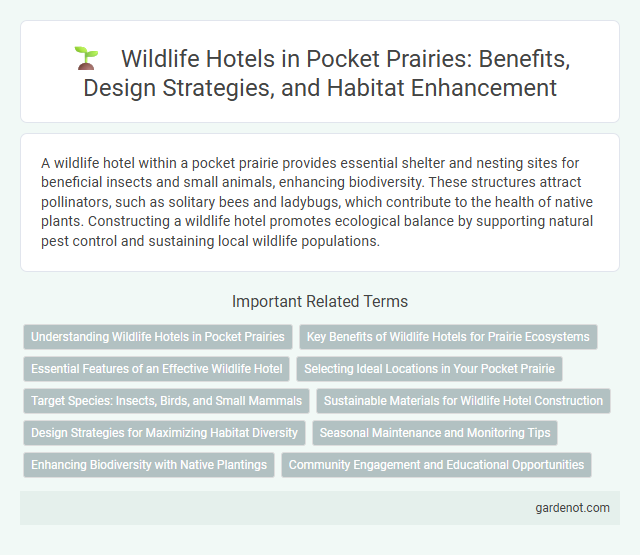A wildlife hotel within a pocket prairie provides essential shelter and nesting sites for beneficial insects and small animals, enhancing biodiversity. These structures attract pollinators, such as solitary bees and ladybugs, which contribute to the health of native plants. Constructing a wildlife hotel promotes ecological balance by supporting natural pest control and sustaining local wildlife populations.
Understanding Wildlife Hotels in Pocket Prairies
Wildlife hotels in pocket prairies provide essential habitats for beneficial insects such as solitary bees, ladybugs, and lacewings, promoting biodiversity and natural pest control. These structures are designed with various materials like hollow stems, wood blocks, and straw, mimicking natural nesting sites to support pollinators and predator species. Incorporating wildlife hotels into pocket prairies enhances ecosystem health by increasing insect populations that contribute to pollination and pest management.
Key Benefits of Wildlife Hotels for Prairie Ecosystems
Wildlife hotels provide essential habitats that support biodiversity within pocket prairies, offering shelter and breeding sites for pollinators, insects, and small mammals. These structures enhance ecosystem resilience by improving pollination rates and natural pest control, which contributes to healthier plant communities. Integrating wildlife hotels into prairie restoration projects promotes ecological balance and strengthens the overall stability of native prairie ecosystems.
Essential Features of an Effective Wildlife Hotel
Effective wildlife hotels provide diverse habitats by incorporating various natural materials such as wood, hollow stems, and dry leaves to attract pollinators, solitary bees, and insects. Proper placement in sunny, sheltered areas enhances shelter and breeding opportunities while protecting inhabitants from predators and harsh weather. Designing multiple compartments that mimic natural nesting sites ensures a safe refuge and supports local biodiversity in pocket prairies.
Selecting Ideal Locations in Your Pocket Prairie
Selecting ideal locations for a wildlife hotel within your pocket prairie involves identifying areas with natural shelter and abundant native plant diversity to support diverse species. Position the wildlife hotel near water sources or flowering plants that attract pollinators and insects, ensuring consistent food supply for birds, amphibians, and beneficial bugs. Avoid highly trafficked or exposed spots to provide a safe, quiet habitat that encourages wildlife habitation and breeding.
Target Species: Insects, Birds, and Small Mammals
A Pocket Prairie Wildlife Hotel provides essential shelter and breeding habitats specifically designed for insects, birds, and small mammals. By incorporating native plants and natural materials, these habitats support pollinators such as bees and butterflies, attract songbirds, and offer refuge for small mammals like chipmunks and shrews. The diverse vegetation and structural features enhance biodiversity and promote ecological balance within urban and suburban environments.
Sustainable Materials for Wildlife Hotel Construction
Sustainable materials such as reclaimed wood, natural stone, and non-toxic paints enhance the durability and environmental friendliness of wildlife hotels in pocket prairies. Using locally sourced bamboo and recycled metal reduces the carbon footprint associated with transportation and manufacturing. These eco-conscious choices provide safe, natural habitats that support biodiversity and promote ecological balance.
Design Strategies for Maximizing Habitat Diversity
Wildlife hotels in pocket prairies utilize layered structures combining various natural materials like hollow stems, wood blocks, and dried leaves to create diverse microhabitats supporting insects, birds, and small mammals. Strategic placement of these elements maximizes sun exposure and moisture retention, encouraging species richness and longevity of shelter. Incorporating native plants and varying cavity sizes further enhances habitat specialization, attracting a broader range of wildlife and promoting ecosystem resilience.
Seasonal Maintenance and Monitoring Tips
Seasonal maintenance of a wildlife hotel in a pocket prairie involves cleaning out old nesting materials in late winter to prevent pest infestations and to prepare for new occupants. Monitor the structure regularly during spring and summer to ensure it remains intact and free from mold or moisture damage, which can affect the health of nesting species. Replace worn components and refresh natural materials like straw or wood shavings to provide a safe, inviting habitat for birds, insects, and small mammals throughout the year.
Enhancing Biodiversity with Native Plantings
Wildlife hotels integrated within pocket prairies provide essential habitats that boost local biodiversity by supporting pollinators, birds, and beneficial insects. Native plantings surrounding these structures create a sustainable ecosystem that offers food, shelter, and breeding grounds crucial for wildlife survival. This combination enhances ecological balance and promotes resilience against environmental stressors in urban and rural settings.
Community Engagement and Educational Opportunities
Wildlife hotels in pocket prairies serve as vital habitats that attract diverse species, enhancing local biodiversity and fostering community engagement through hands-on conservation efforts. These structures provide educational opportunities by allowing residents and students to observe and learn about native wildlife behavior and ecosystem interactions firsthand. Community involvement in maintaining wildlife hotels strengthens environmental stewardship and promotes awareness of sustainable practices within urban green spaces.
Wildlife hotel Infographic

 gardenot.com
gardenot.com